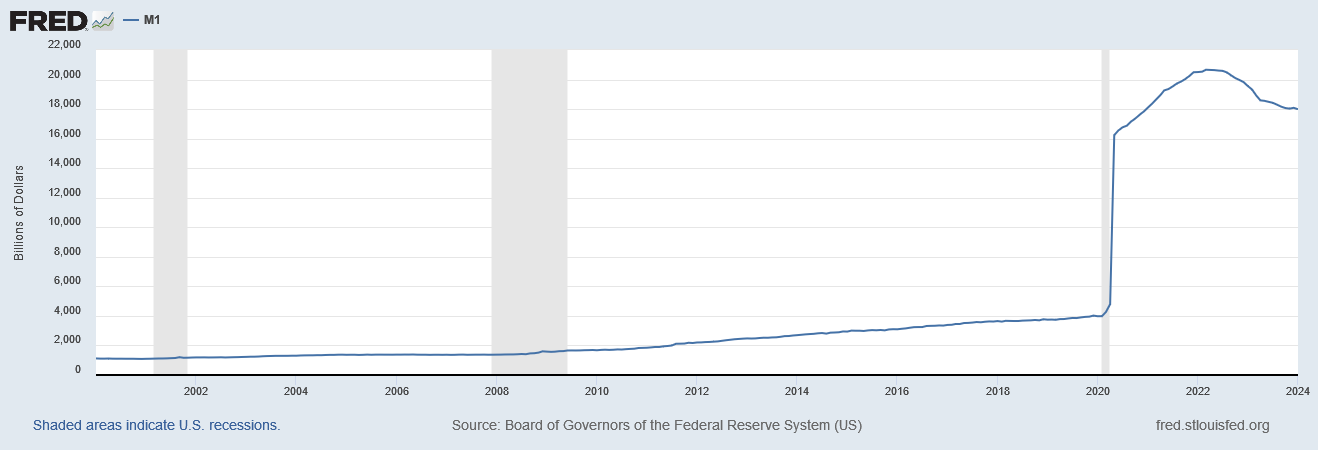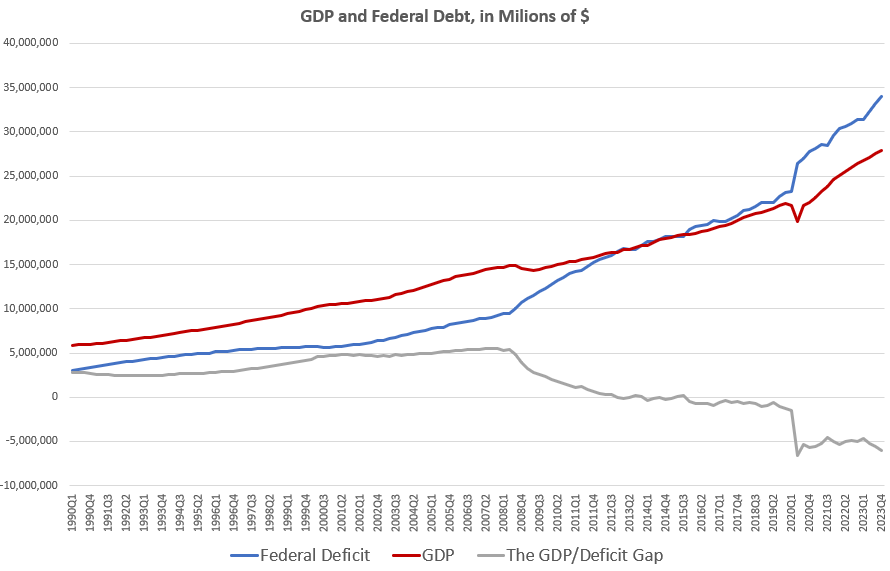$1 Trillion Per 100 Days: Is This the Year the Debt Bubble Explodes?
"As long as the Fed exists, the likelihood of truly reigning in out-of-control debt is nothing but a pipe dream."
With a stunning trillion dollars added to the national debt in only three months, projected to reach an incomprehensible $54 trillion within 10 years, and America’s interest payments on track to exceed defense spending next year, the question must be asked: How much longer can the debt bubble go?
It’s a curious situation when Jerome Powell, a man who oversaw the largest money-printing campaign in American history, is saying that the debt is unsustainable. While maintaining that the Fed “tries hard not to comment on fiscal policy,” Powell’s suggestion for handling the debt shifts blame and burden from money printing to fiscal irresponsibility on the part of policymakers.
While they have their part to play, and it’s a big one, it’s interesting to see that Federal Reserve monetary policy hasn’t been mentioned in any of Powell’s ‘urgent’ warnings about ballooning debt:
“In the long run, the U.S. is on an unsustainable fiscal path. The U.S. federal government’s on an unsustainable fiscal path. And that just means that the debt is growing faster than the economy. So, it is unsustainable. I don’t think that’s at all controversial. And I think we know that we have to get back on a sustainable fiscal path.”
It’s a wonder how, even if the government suddenly adopted responsible spending and budgeting, we would be back on a path of true sustainability after Powell oversaw the printing of over 3 trillion dollars in 2020 alone. The Fed is an interesting source of criticism for unsustainable debt, to say the least:
M1 Supply Growth (Billions), 2000-2024, From St. Louis Fed Data
Source: Board of Governors of the Federal Reserve System (US), M1 [M1SL], retrieved from FRED, Federal Reserve Bank of St. Louis; March 6, 2024.
But as usual, the Fed only has one real tool in its toolbox: tinkering with interest rates directly to stimulate or disincentivize borrowing, or indirectly by firing up the money printer. Rate cuts expected later this year will reduce the burden of interest payments on debt growth, but simultaneously will flood the economy with newly-created money. People, already over-indebted and using credit cards for basic needs, will take advantage of a lower cost of borrowing and sign up for more loans for expenses and goods that they can’t really afford.
More loans and more deposits will increase M1 in an already-frothy inflationary environment, adding pressure to a pot that’s already in danger of boiling over from money printing during Covid. Post-COVID rate hikes have not even come close to reversing this course, with interest still far lower than it would be in an actual free market, where a few dozen bureaucrats would no longer be pulling the levers. Excessive borrowing makes US Treasurys less attractive as doubts begin to mount that the US will be able to pay its obligations back, decreasing demand for our debt and fueling further challenges for funding the government.
All of this led Fitch and Moody’s to downgrade the US’s credit rating last year, from “AAA” to “AA+” in the case of Fitch, and for Moody’s, from “stable” to “negative.” Fed interest rate hikes without an accompanying plan to reduce spending or increase revenue leave no hope at all for meaningfully reducing fiscal deficits.
From this new sense of urgency, lawmakers in Idaho and Wyoming have called for a convention of states to address the problem, with Idaho’s resolutions calling for a possible constitutional amendment limiting the spending abilities and overall power of the federal government. Idaho’s Senate Concurrent Resolution 112, or SCR 112, calls for, in its words:
“(1) imposing fiscal restraints on the federal government; (2) limiting the power and jurisdiction of the federal government; and (3) limiting the terms in office for its officials and for members of Congress. Currently, identical applications have been sent to Congress by other state legislatures.”
The question remains if anything, at this point, would be enough to get the US back on a genuinely sustainable economic track other than an outright collapse of the US dollar leading to a total monetary reset. As long as the Fed exists, the likelihood of truly reigning in out-of-control debt is nothing but a pipe dream.
With recent new all-time highs for gold and bitcoin in response to the debasement of the debt and central banks locked in a buying spree that is likely to last years, the message is clear that the banking system agrees with Peter Schiff that inflation is far from over.
Massive Deficit Spending Tows US Economy Forward
Rampant government spending continues to mask fundamental weaknesses in the US economy. Recently, national debt grew much faster than the economy for the third quarter in a row, just one of many warning signs concerning legendary investors. Our guest commentator explains just how much the government is spending to make the economy seem strong, even as the US remains in the midst of a “private sector recession.
The following article was originally published by the Mises Institute. The opinions expressed do not necessarily reflect those of Peter Schiff or SchiffGold.
Over the past year, economist Daniel Lacalle has repeatedly warned that the United States is in the midst of a “private sector recession” and that official GDP measures are being propped up by government spending. The latest GDP numbers from the federal government strongly suggest he is right.
Today, the federal government’s Bureau of Economic Analysis released its revised estimate for GDP growth in the fourth quarter of 2023. According to the report, total GDP increased $334.5 billion (quarter over quarter) during the fourth quarter. That’s down from the third quarter’s quarter-over-quarter increase of $547.1 billion, but is nonetheless an ostensibly robust rate of growth.
Yet, if we compare GDP growth during the fourth quarter to growth in the total national debt, we find that the numbers don’t look quite so robust after all. While GDP may have grown by $334 billion during the period, the national debt grew by more than twice as much: $834 billion. In other words, for every dollar of GDP growth, the national debt grew by 2.7 dollars.
Moreover, this is the third quarter in a row during which debt growth has substantially outpaced GDP growth. During the third quarter, the federal debt grew $1.5 dollars for every dollar of GDP growth. During the first quarter, the debt grew 3.5 dollars for every dollar of GDP growth.
The fact that this has now happened three quarters in a row is notable as well. Over the past fifty years, it is rare to find debt growth exceeding GDP growth for more than two quarters in a row except during periods of economic weakness when the federal government relies on monetary expansion and federal spending to “stimulate” economic growth. For example, we find a three-quarter streak during the Great Recession and the years immediately afterward—when job growth was extremely weak. The same can also be seen in the quarters following the 2001 recession.
This isn’t shocking. If the federal government is trying to boost GDP numbers through “stimulus” it will both spend freely and expand the money supply as the central bank purchases Treasuries to avoid a surge in interest rates. (See more on how the central bank enables deficit spending.) The current reliance on federal deficit spending to keep up the appearance of GDP growth further backs up Lacalle’s theory that the United States is in the midst of both a public-sector expansion and a private-sector contraction. That is, the private sector is experiencing many recessionary trends, such as falling real wages, a decline in manufacturing, and growing bankruptcies. Meanwhile, however, government spending is booming, so sectors of the economy that are closely tied to government spending continue to expand. In aggregate, total GDP numbers thus show an increase, even as the private sector stagnates.
After all, it’s important to keep in mind that GDP measures include government spending, and will also include the consumption that results from additional government spending on welfare programs, weapons manufacturing, and more. As the federal government spends its deficit-financed dollars, the recipients of these dollars consume more, thus pushing up current GDP.
The general problem with this trend can be seen if we apply it to a private firm. Imagine, for instance, that a private firm managed to increase its production by a million dollars, but at the same time took on an additional $2.5 million in debt to buy new sports cars for its least productive employees. Even worse, this new debt is in addition to a huge existing debt load.
This sort of debt should never be confused with good debt, which is debt taken on to fund new capital goods. That could potentially increase productivity later on. Government debit never good debt, however, because it is taken on for purposes of immediate consumption—usually on social welfare benefits or on bombing faraway countries.
Unfortunately, as we find debt growth repeatedly top GDP growth, we are likely to see more of this phenomenon moving forward. The federal debt is now larger than the entire GDP of the United States, and the gap between debt and GDP in each year has now widened to more than six trillion dollars. As this trend continues, expect to see deficit spending play a larger and larger role in GDP.
Schiff Gold: Interested in learning how to buy gold and buy silver? Call 1-888-GOLD-160 and speak with a Precious Metals Specialist today!
QTR’s Disclaimer: I am not a guru or an expert. I am an idiot writing a blog and often get things wrong and lose money. I do not fact check contributor material that I aggregate from other sources. I may own or transact in any names mentioned in this piece at any time without warning and generally trade like a degenerate psychopath. This is not a recommendation to buy or sell any stocks or securities or any asset class - just my opinions of me and my guests. I often lose money on positions I trade/invest in and I’m sure have lost more than I’ve made in my time in markets. I may add any name mentioned in this article and sell any name mentioned in this piece at any time, without further warning. Positions can change immediately as soon as I publish this, with or without notice. You are on your own. Do not make decisions based on my blog. I exist on the fringe. The publisher does not guarantee the accuracy or completeness of the information provided in this page. These are not the opinions of any of my employers, partners, or associates. I did my best to be honest about my disclosures but can’t guarantee I am right; I write these posts after a couple beers sometimes. Also, I just straight up get shit wrong a lot. I mention it three times because it’s that important.








Do you think Javier Milei has the right idea?
Are we not in the most massive money manufacturing episode of human history?